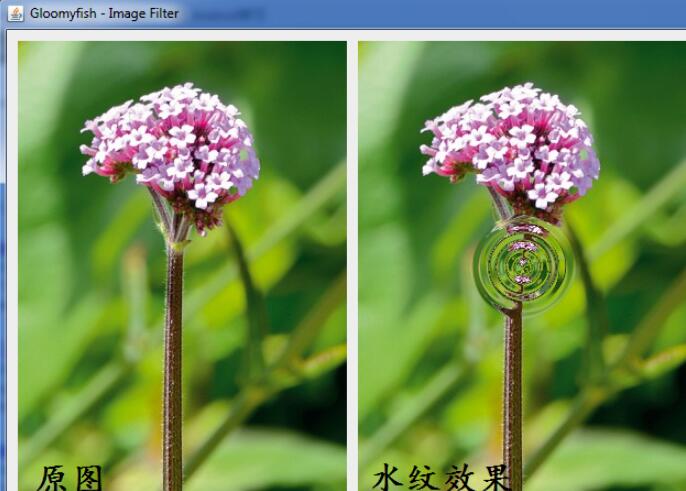жВ®е•љпЉМзЩїељХеРОжЙНиГљдЄЛиЃҐеНХеУ¶пЉБ
жВ®е•љпЉМзЩїељХеРОжЙНиГљдЄЛиЃҐеНХеУ¶пЉБ
ињЩзѓЗжЦЗзЂ†зїЩе§ІеЃґеИЖдЇЂзЪДжШѓжЬЙеЕ≥javaе¶ВдљХеЃЮзО∞ж∞іж≥ҐзЇєжЙ©жХ£жХИжЮЬзЪДеЖЕеЃєгАВе∞ПзЉЦиІЙеЊЧжМЇеЃЮзФ®зЪДпЉМеЫ†ж≠§еИЖдЇЂзїЩе§ІеЃґеБЪдЄ™еПВиАГпЉМдЄАиµЈиЈЯйЪПе∞ПзЉЦињЗжЭ•зЬЛзЬЛеРІгАВ
дЄАгАБеОЯзРЖ
ж®°жЛЯж∞іж≥ҐзЇєжХИжЮЬпЉМжЬАеЄЄиІБзЪДжШѓsineжИЦиАЕcosnзЪДеЗљжХ∞пЉМеС®жЬЯжАІеПШеМЦпЉМиііињСиЗ™зДґгАВ
ељУж∞іж≥ҐзЇєдЄ≠дЄ≠йЧіеЉАеІЛеРСеЫЫеС®жЙ©жХ£зЪДжЧґеАЩпЉМдЄАиИђйГљжШѓжЕҐжЕҐзЪД姱еОїиГљйЗПпЉМжМѓеєЕдєЯжШѓиґКжЭ•иґКе∞ПпЉМжЙАдї•з®ЛеЇПи¶Бж®°жЛЯињЩдЄ™ињЗз®ЛжЧґеАЩпЉМи¶БеК†дЄКдЄАдЄ™иГљйЗПйАТеЗПеЫ†е≠РгАВзДґеРОзФ®еЕђеЉП y = a*sine(bx + c)жЭ•и°®з§Їж≥ҐзЇєеЕђеЉПгАВ
дЇМгАБз®ЛеЇПеЃЮзО∞
жЬАйЗНи¶БзЪДдЄАж≠•жШѓиЃ°зЃЧж∞іж≥ҐзЇєзЪДжМѓеєЕгАВеЬ®дїїжДПдЄАзВєз°ЃеЃЪж∞іж≥ҐзЪДдЄ≠ењГдљНзљЃпЉМеПѓдї•жШѓйЉ†ж†ЗйЪПжЬЇйАЙеПЦпЉМеѓєеНКеЊДиМГеЫіеЖЕзЪДеГПзі†дљНзљЃеЃЮзО∞ж∞іж≥ҐзФЯжИРпЉМзДґеРОиљђжНҐдЄЇдљНзљЃпЉМеѓєдљНзљЃеЃЮзО∞жµЃзВєжХ∞еПЦжХіпЉМзДґеРОдљњзФ®йАВељУзЪДжПТеАЉзЃЧж≥ХпЉМжЬђдЊЛдљњзФ®еПМзЇњжАІжПТеАЉгАВ
дЄЙгАБз®ЛеЇПжХИжЮЬ

еЫЫгАБжї§йХЬеЃМеЕ®жЇРдї£з†Б
ињЩжђ°жИСеЖЩдЇЖдЇЫдЄ≠жЦЗж≥®иІ£пЉМдЄНзїЩжЇРдї£з†БзЪДеНЪжЦЗдЄНжШѓе•љеНЪжЦЗ
package com.gloomyfish.filter.study; import java.awt.image.BufferedImage; public class WaterFilter extends AbstractBufferedImageOp { private float wavelength = 16; private float amplitude = 10; private float phase = 0; private float centreX = 0.5f; private float centreY = 0.5f; private float radius = 50; private float radius2 = 0; private float icentreX; private float icentreY; public WaterFilter() { } @Override public BufferedImage filter(BufferedImage src, BufferedImage dest) { int width = src.getWidth(); int height = src.getHeight(); if ( dest == null ) dest = createCompatibleDestImage( src, null ); int[] inPixels = new int[width*height]; int[] outPixels = new int[width*height]; getRGB( src, 0, 0, width, height, inPixels ); icentreX = width * centreX; icentreY = height * centreY; if ( radius == 0 ) radius = Math.min(icentreX, icentreY); radius2 = radius*radius; int index = 0; float[] out = new float[2]; for(int row=0; row<height; row++) { for(int col=0; col<width; col++) { index = row * width + col; // иОЈеПЦж∞іж≥ҐзЪДжЙ©жХ£дљНзљЃпЉМжЬАйЗНи¶БзЪДдЄАж≠• generateWaterRipples(col, row, out); int srcX = (int)Math.floor( out[0] ); int srcY = (int)Math.floor( out[1] ); float xWeight = out[0]-srcX; float yWeight = out[1]-srcY; int nw, ne, sw, se; // иОЈеПЦеС®еЫіеЫЫдЄ™еГПзі†пЉМжПТеАЉзФ®пЉМ if ( srcX >= 0 && srcX < width-1 && srcY >= 0 && srcY < height-1) { // Easy case, all corners are in the image int i = width*srcY + srcX; nw = inPixels[i]; ne = inPixels[i+1]; sw = inPixels[i+width]; se = inPixels[i+width+1]; } else { // Some of the corners are off the image nw = getPixel( inPixels, srcX, srcY, width, height ); ne = getPixel( inPixels, srcX+1, srcY, width, height ); sw = getPixel( inPixels, srcX, srcY+1, width, height ); se = getPixel( inPixels, srcX+1, srcY+1, width, height ); } // еПЦеЊЧеѓєеЇФзЪДжМѓеєЕдљНзљЃP(x, y)зЪДеГПзі†пЉМдљњзФ®еПМзЇњжАІжПТеАЉ /*if(xWeight >=0 || yWeight >= 0) { outPixels[index] = ImageMath.bilinearInterpolate(xWeight, yWeight, nw, ne, sw, se); } else { outPixels[index] = inPixels[index]; }*/ outPixels[index] = ImageMath.bilinearInterpolate(xWeight, yWeight, nw, ne, sw, se); } } setRGB( dest, 0, 0, width, height, outPixels ); return dest; } private int getPixel(int[] pixels, int x, int y, int width, int height) { if (x < 0 || x >= width || y < 0 || y >= height) { return 0; // жЬЙзВєжЪіеКЫеХ¶пЉМжЗТеЊЧзЃ°еХ¶ } return pixels[ y*width+x ]; } protected void generateWaterRipples(int x, int y, float[] out) { float dx = x-icentreX; float dy = y-icentreY; float distance2 = dx*dx + dy*dy; // з°ЃеЃЪ water rippleзЪДеНКеЊДпЉМе¶ВжЮЬеЬ®еНКеЊДдєЛе§ЦпЉМе∞±зЫіжО•иОЈеПЦеОЯжЭ•дљНзљЃпЉМдЄНзФ®иЃ°зЃЧињБзІїйЗП if (distance2 > radius2) { out[0] = x; out[1] = y; } else { // е¶ВжЮЬеЬ®radiusеНКеЊДдєЛеЖЕпЉМиЃ°зЃЧеЗЇжЭ• float distance = (float)Math.sqrt(distance2); // иЃ°зЃЧжФєзВєжМѓеєЕ float amount = amplitude * (float)Math.sin(distance / wavelength * ImageMath.TWO_PI - phase); // иЃ°зЃЧиГљйЗПжНЯ姱пЉМ amount *= (radius-distance)/radius; // иЃ°зЃЧиГљйЗПжНЯ姱пЉМ if ( distance != 0 ) amount *= wavelength/distance; // еЊЧеИ∞water ripple жЬАзїИињБзІїдљНзљЃ out[0] = x + dx*amount; out[1] = y + dy*amount; } } }жДЯи∞ҐеРДдљНзЪДйШЕиѓїпЉБеЕ≥дЇОвАЬjavaе¶ВдљХеЃЮзО∞ж∞іж≥ҐзЇєжЙ©жХ£жХИжЮЬвАЭињЩзѓЗжЦЗзЂ†е∞±еИЖдЇЂеИ∞ињЩйЗМдЇЖпЉМеЄМжЬЫдї•дЄКеЖЕеЃєеПѓдї•еѓєе§ІеЃґжЬЙдЄАеЃЪзЪДеЄЃеК©пЉМиЃ©е§ІеЃґеПѓдї•е≠¶еИ∞жЫіе§ЪзЯ•иѓЖпЉМе¶ВжЮЬиІЙеЊЧжЦЗзЂ†дЄНйФЩпЉМеПѓдї•жККеЃГеИЖдЇЂеЗЇеОїиЃ©жЫіе§ЪзЪДдЇЇзЬЛеИ∞еРІпЉБ
еЕНиі£е£∞жШОпЉЪжЬђзЂЩеПСеЄГзЪДеЖЕеЃєпЉИеЫЊзЙЗгАБиІЖйҐСеТМжЦЗе≠ЧпЉЙдї•еОЯеИЫгАБиљђиљљеТМеИЖдЇЂдЄЇдЄїпЉМжЦЗзЂ†иІВзВєдЄНдї£и°®жЬђзљСзЂЩзЂЛеЬЇпЉМе¶ВжЮЬжґЙеПКдЊµжЭГиѓЈиБФз≥їзЂЩйХњйВЃзЃ±пЉЪis@yisu.comињЫи°МдЄЊжК•пЉМеєґжПРдЊЫзЫЄеЕ≥иѓБжНЃпЉМдЄАзїПжЯ•еЃЮпЉМе∞ЖзЂЛеИїеИ†йЩ§жґЙеЂМдЊµжЭГеЖЕеЃєгАВ